pip install ultralytics
# pip install opencv-python
# If using jupyter notebook create jupyter kernel
pip install ipykernel
# register the kernel
python -m ipykernel install --user --name=venv_opencv --display-name "Py venv_opencv"
# Open notebook
jupyter notebookCar Counter Y8
We will use part of what we covered in masks, regions, line/threshold to create a car counter model.
Setup
After
- creating a folder
- a venv
- activate environment
- install the following:
We will copy the code we used earlier to detect objects from the video and start from there.
from ultralytics import YOLO
import cv2 # we will use this later
import matplotlib as plt
import math
from cv_utils import *
cap = cv2.VideoCapture("../cars.mp4") # For Video
win_name = "Car Counter"
model = YOLO("../Yolo-Weights/yolov8l.pt")
# List of Class names
classNames = ["person", "bicycle", "car", "motorbike", "aeroplane", "bus", "train", "truck", "boat",
"traffic light", "fire hydrant", "stop sign", "parking meter", "bench", "bird", "cat",
"dog", "horse", "sheep", "cow", "elephant", "bear", "zebra", "giraffe", "backpack", "umbrella",
"handbag", "tie", "suitcase", "frisbee", "skis", "snowboard", "sports ball", "kite", "baseball bat",
"baseball glove", "skateboard", "surfboard", "tennis racket", "bottle", "wine glass", "cup",
"fork", "knife", "spoon", "bowl", "banana", "apple", "sandwich", "orange", "broccoli",
"carrot", "hot dog", "pizza", "donut", "cake", "chair", "sofa", "pottedplant", "bed",
"diningtable", "toilet", "tvmonitor", "laptop", "mouse", "remote", "keyboard", "cell phone",
"microwave", "oven", "toaster", "sink", "refrigerator", "book", "clock", "vase", "scissors",
"teddy bear", "hair drier", "toothbrush"
]
while cap.isOpened():
# Read frame from video
success, frame = cap.read()
if success: # if frame is read successfully set the results of the model on the frame
results = model(frame, stream=True)
# Insert Box Extraction section here
for r in results:
boxes = r.boxes
for box in boxes:
x1, y1, x2, y2 = box.xyxy[0]
x1, y1, x2, y2 = int(x1), int(y1), int(x2), int(y2) # convert values to integers
cv2.rectangle(frame, (x1, y1), (x2, y2), (0, 255, 0), 3)
# we can also use a function from cvzone/utils.py called
# cvzone.cornerRect(img,(x1,y1,w,h))
# extract the confidence level
conf = math.ceil(box.conf[0] * 100) / 100
# extract class ID
cls = int(box.cls[0])
# display both conf & class ID on frame
putTextRect(frame, f'{conf} {classNames[cls]}', (max(0, x1), max(35, y1)), scale=0.6, thickness=1, offset=5)
cv2.imshow(win_name, frame)
if cv2.waitKey(1) == 27:
break # if user breaks with ESC key
else:
break # if end of video is reached
# Release video capture object and close display window
cap.release()
cv2.destroyAllWindows()All we have done from the previous code is to change the source file to the cars.mp4
# OUTPUT
0: 384x640 1 person, 14 cars, 1 truck, 1 traffic light, 1 stop sign, 564.7ms
Speed: 8.9ms preprocess, 564.7ms inference, 42.6ms postprocess per image at shape (1, 3, 384, 640)
0: 384x640 1 person, 14 cars, 1 truck, 1 traffic light, 1 stop sign, 403.3ms
Speed: 2.2ms preprocess, 403.3ms inference, 0.9ms postprocess per image at shape (1, 3, 384, 640)
0: 384x640 1 person, 16 cars, 1 truck, 1 traffic light, 1 stop sign, 377.7ms
Speed: 1.4ms preprocess, 377.7ms inference, 0.9ms postprocess per image at shape (1, 3, 384, 640)
0: 384x640 1 person, 16 cars, 1 traffic light, 1 stop sign, 373.4ms
Speed: 2.4ms preprocess, 373.4ms inference, 1.0ms postprocess per image at shape (1, 3, 384, 640)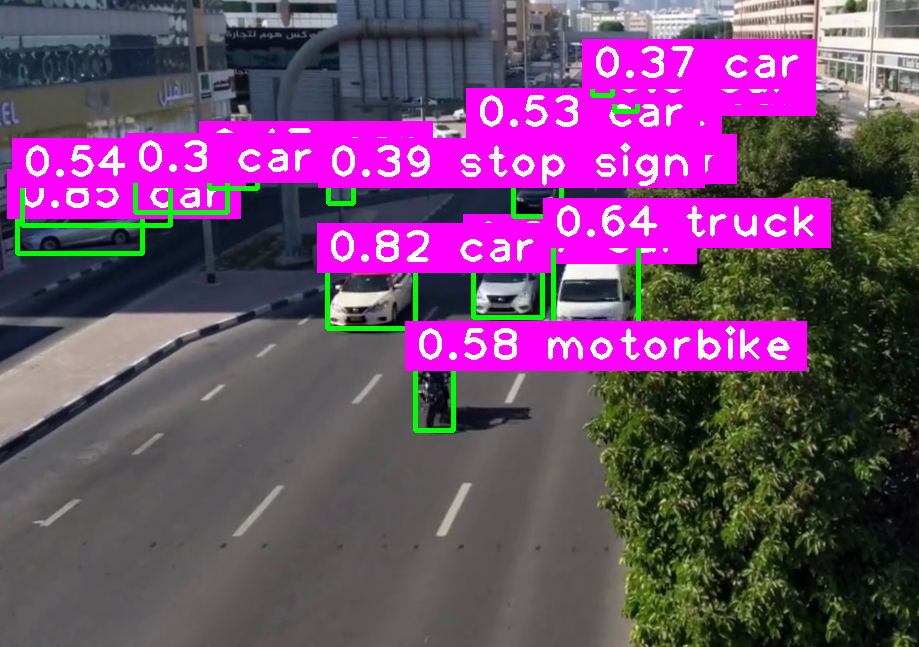
As you see it is detecting cars on the shoulder and not moving…. So we will have to narrow our detection region with either using a mask or regions.
Adjust Text Size
- Before we get started with the mask let’s fix some cosmetic issues by editing the line above to
# display both conf & class ID on frame - scale down the bos as it is too big
putTextRect(frame, f'{conf} {classNames[cls]}', (max(0, x1), max(35, y1)), scale=0.6, thickness=1, offset=5)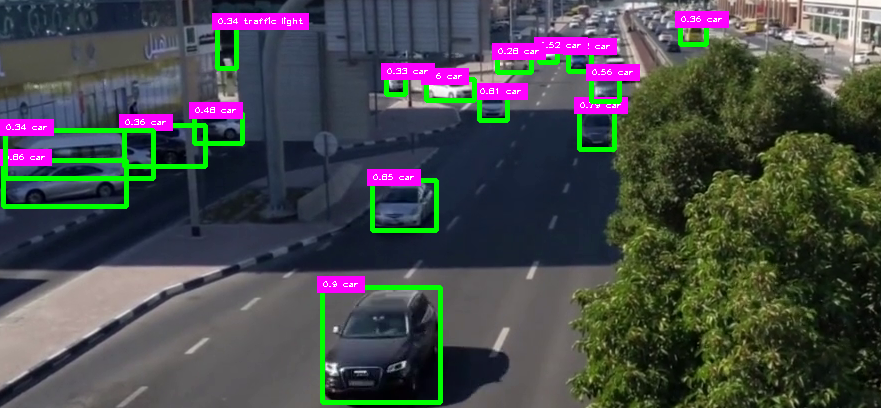
Filter Classes
Let’s say out of the long list of classes we only want to detect
- Car
- Bus
- Truck
So we need to use an if statement to exclude other classes
- we already have cls as the class id
- so we can create a wantedClass to be a list derived from the classNames list
- then we filter the detection to the wanted classes
- we can also filter out a confidence level with conf
- Let’s also change the waitkey(0) to 0 instead of 27 - 0 signifies tab bar, so we want it to stop at each frame till the user presses the tab
# extract class ID
cls = int(box.cls[0])
wantedClass = classNames[cls]
if wantedClass == "car" or wantecClass == "bus" or wantecClass == "truck" and conf >0.3:
putTextRect(frame, f'{conf} {classNames[cls]}', (max(0, x1), max(35, y1)), scale=0.6, thickness=1, offset=5)so our code becomes
from ultralytics import YOLO
import cv2 # we will use this later
import matplotlib as plt
import math
from cv_utils import *
cap = cv2.VideoCapture("../cars.mp4") # For Video
win_name = "Car Counter"
model = YOLO("../Yolo-Weights/yolov8l.pt")
# List of Class names
classNames = ["person", "bicycle", "car", "motorbike", "aeroplane", "bus", "train", "truck", "boat",
"traffic light", "fire hydrant", "stop sign", "parking meter", "bench", "bird", "cat",
"dog", "horse", "sheep", "cow", "elephant", "bear", "zebra", "giraffe", "backpack", "umbrella",
"handbag", "tie", "suitcase", "frisbee", "skis", "snowboard", "sports ball", "kite", "baseball bat",
"baseball glove", "skateboard", "surfboard", "tennis racket", "bottle", "wine glass", "cup",
"fork", "knife", "spoon", "bowl", "banana", "apple", "sandwich", "orange", "broccoli",
"carrot", "hot dog", "pizza", "donut", "cake", "chair", "sofa", "pottedplant", "bed",
"diningtable", "toilet", "tvmonitor", "laptop", "mouse", "remote", "keyboard", "cell phone",
"microwave", "oven", "toaster", "sink", "refrigerator", "book", "clock", "vase", "scissors",
"teddy bear", "hair drier", "toothbrush"
]
while cap.isOpened():
# Read frame from video
success, frame = cap.read()
if success: # if frame is read successfully set the results of the model on the frame
results = model(frame, stream=True)
# Insert Box Extraction section here
for r in results:
boxes = r.boxes
for box in boxes:
x1, y1, x2, y2 = box.xyxy[0]
x1, y1, x2, y2 = int(x1), int(y1), int(x2), int(y2) # convert values to integers
cv2.rectangle(frame, (x1, y1), (x2, y2), (0, 255, 0), 3)
# we can also use a function from cvzone/utils.py called
# cvzone.cornerRect(img,(x1,y1,w,h))
# extract the confidence level
conf = math.ceil(box.conf[0] * 100) / 100
# extract class ID
cls = int(box.cls[0])
wantedClass = classNames[cls]
# filter out unwanted classes from detection
if wantedClass == "car" or wantedClass == "bus" or wantedClass == "truck" and conf > 0.3:
# display both conf & class ID on frame - scale down the bos as it is too big
putTextRect(frame, f'{conf} {classNames[cls]}', (max(0, x1), max(35, y1)), scale=0.6, thickness=1, offset=5)
cv2.imshow(win_name, frame)
key = cv2.waitKey(0) # wait for key press
if key == ord(" "): # a space bar will display the next frame
continue
elif key == 27: # escape will exit
break
# Release video capture object and close display window
cap.release()
cv2.destroyAllWindows()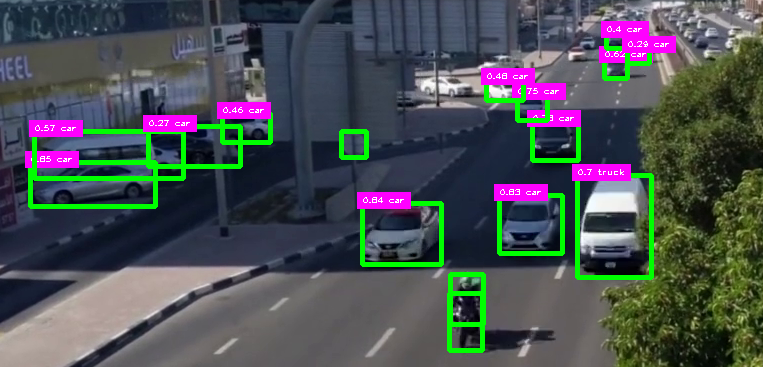
Omit Unwanted BB
- As you see above, we have unwanted classes that are still detected and not labeled, we want the model to not draw the BB for them
- So all we do is move thecv2.rectangle() line to inside the wanted if statement
- As you see below the person on the motorcycle is no longer shown with a BB
- The stop sign is no longer displayed anymore as well
- So what’s left is to mask out the unwanted areas in the image
- Now we can refer to the masking page, as I’ll just include the code in the next paragraph without explanation
if wantedClass == "car" or wantedClass == "bus" or wantedClass == "truck" and conf > 0.3:
# display both conf & class ID on frame - scale down the bos as it is too big
cv2.rectangle(frame, (x1, y1), (x2, y2), (0, 255, 0), 3)
putTextRect(frame, f'{conf} {classNames[cls]}', (max(0, x1), max(35, y1)), scale=0.6, thickness=1, offset=5)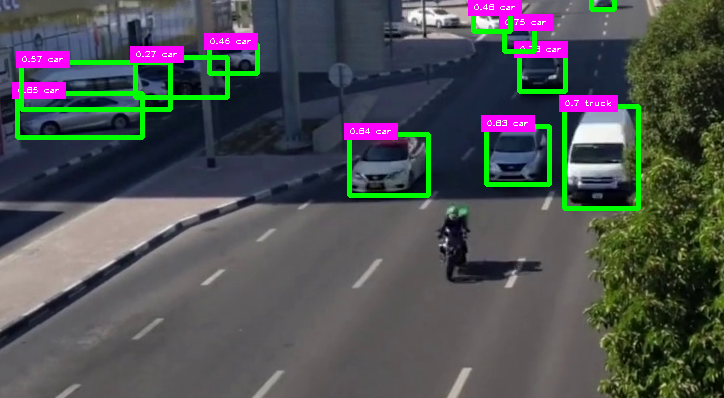
Mask
- If we just add the mask we get the image below
- You can clearly see that the cars will not be detected until they enter the desired region
- More details about masking is in the appropriate page
from ultralytics import YOLO
import cv2 # we will use this later
import matplotlib as plt
import math
from cv_utils import *
cap = cv2.VideoCapture("../cars.mp4") # For Video
mask = cv2.imread("../car_counter_mask1.png") # For mask
win_name = "Car Counter"
model = YOLO("../Yolo-Weights/yolov8l.pt")
# List of Class names
classNames = ["person", "bicycle", "car", "motorbike", "aeroplane", "bus", "train", "truck", "boat",
"traffic light", "fire hydrant", "stop sign", "parking meter", "bench", "bird", "cat",
"dog", "horse", "sheep", "cow", "elephant", "bear", "zebra", "giraffe", "backpack", "umbrella",
"handbag", "tie", "suitcase", "frisbee", "skis", "snowboard", "sports ball", "kite", "baseball bat",
"baseball glove", "skateboard", "surfboard", "tennis racket", "bottle", "wine glass", "cup",
"fork", "knife", "spoon", "bowl", "banana", "apple", "sandwich", "orange", "broccoli",
"carrot", "hot dog", "pizza", "donut", "cake", "chair", "sofa", "pottedplant", "bed",
"diningtable", "toilet", "tvmonitor", "laptop", "mouse", "remote", "keyboard", "cell phone",
"microwave", "oven", "toaster", "sink", "refrigerator", "book", "clock", "vase", "scissors",
"teddy bear", "hair drier", "toothbrush"
]
while cap.isOpened():
success, frame = cap.read() # read frame from video
imgRegion = cv2.bitwise_and(frame, mask) #place mask over frame
if success: # if frame is read successfully set the results of the model on the frame
# results = model(frame, stream=True)
results = model(imgRegion, stream=True) # now we send the masked region to the model instead of the frame
# Insert Box Extraction section here
for r in results:
boxes = r.boxes
for box in boxes:
x1, y1, x2, y2 = box.xyxy[0]
x1, y1, x2, y2 = int(x1), int(y1), int(x2), int(y2) # convert values to integers
#cv2.rectangle(frame, (x1, y1), (x2, y2), (0, 255, 0), 3)
# we can also use a function from cvzone/utils.py called
# cvzone.cornerRect(img,(x1,y1,w,h))
# extract the confidence level
conf = math.ceil(box.conf[0] * 100) / 100
# extract class ID
cls = int(box.cls[0])
wantedClass = classNames[cls]
# filter out unwanted classes from detection
if wantedClass == "car" or wantedClass == "bus" or wantedClass == "truck" and conf > 0.3:
# display both conf & class ID on frame - scale down the bos as it is too big
cv2.rectangle(frame, (x1, y1), (x2, y2), (0, 255, 0), 3)
putTextRect(frame, f'{conf} {classNames[cls]}', (max(0, x1), max(35, y1)), scale=0.6, thickness=1, offset=5)
cv2.imshow(win_name, frame) # display frame
cv2.imshow("MaskedRegion", imgRegion) # display mask over frame
key = cv2.waitKey(0) # wait for key press
if key == ord(" "): # a space bar will display the next frame
continue
elif key == 27: # escape will exit
break
# Release video capture object and close display window
cap.release()
cv2.destroyAllWindows()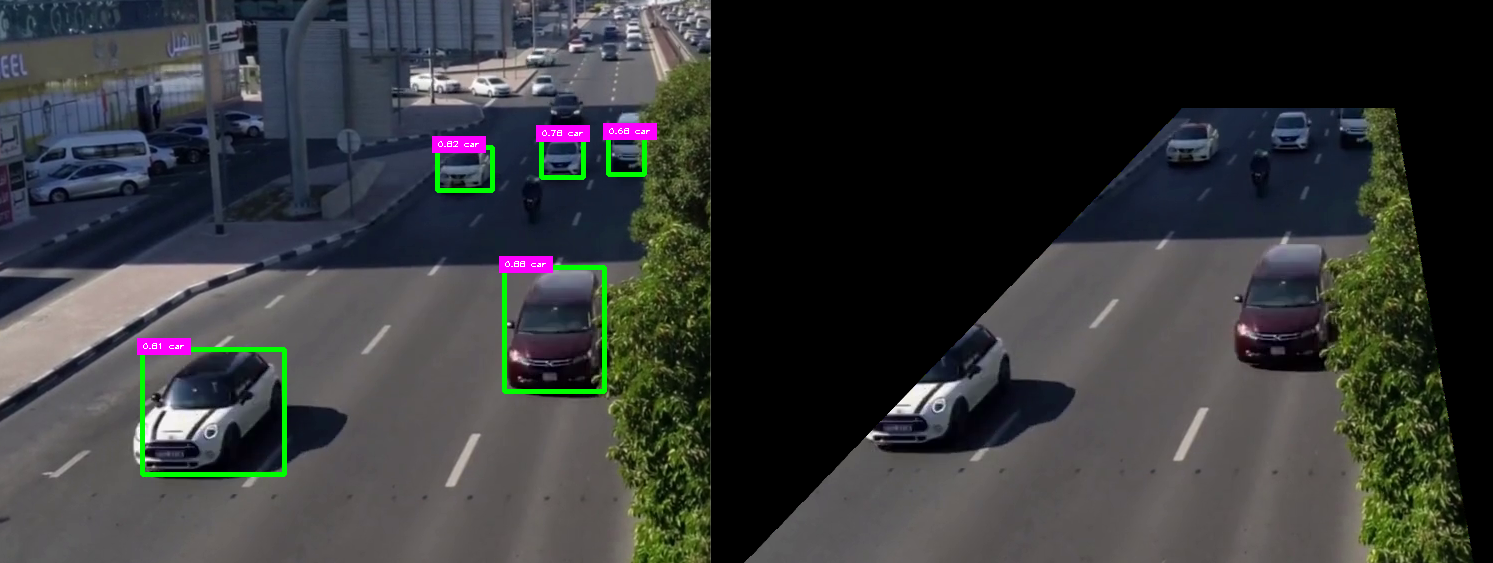
- If we comment out the line below we end up with
cv2.imshow("MaskedRegion", imgRegion) # display mask over frame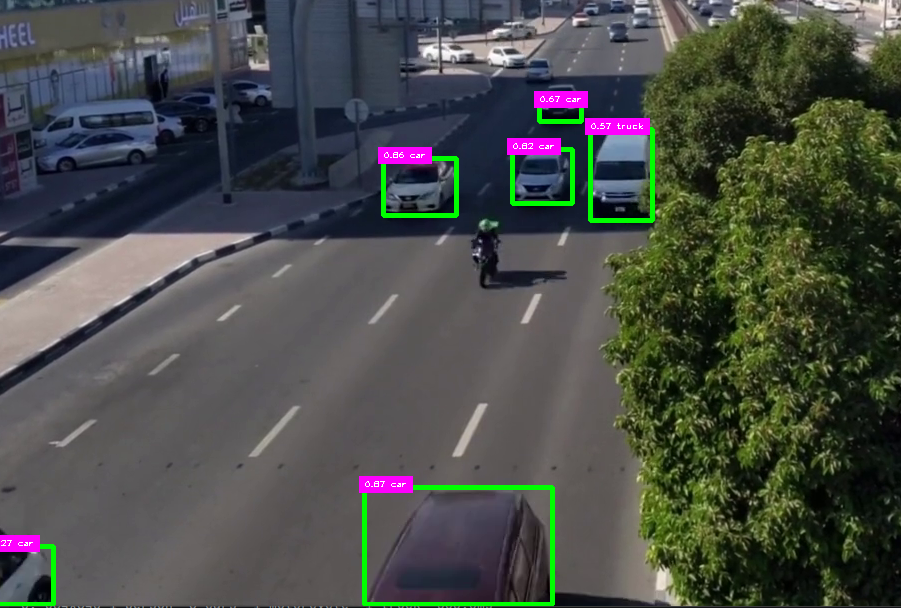
Count Cars
- In order to count cars we need to establish an area where once the object passes over it the model will accrue another object to its total.
- Once again refer to the Count Objects page for more details